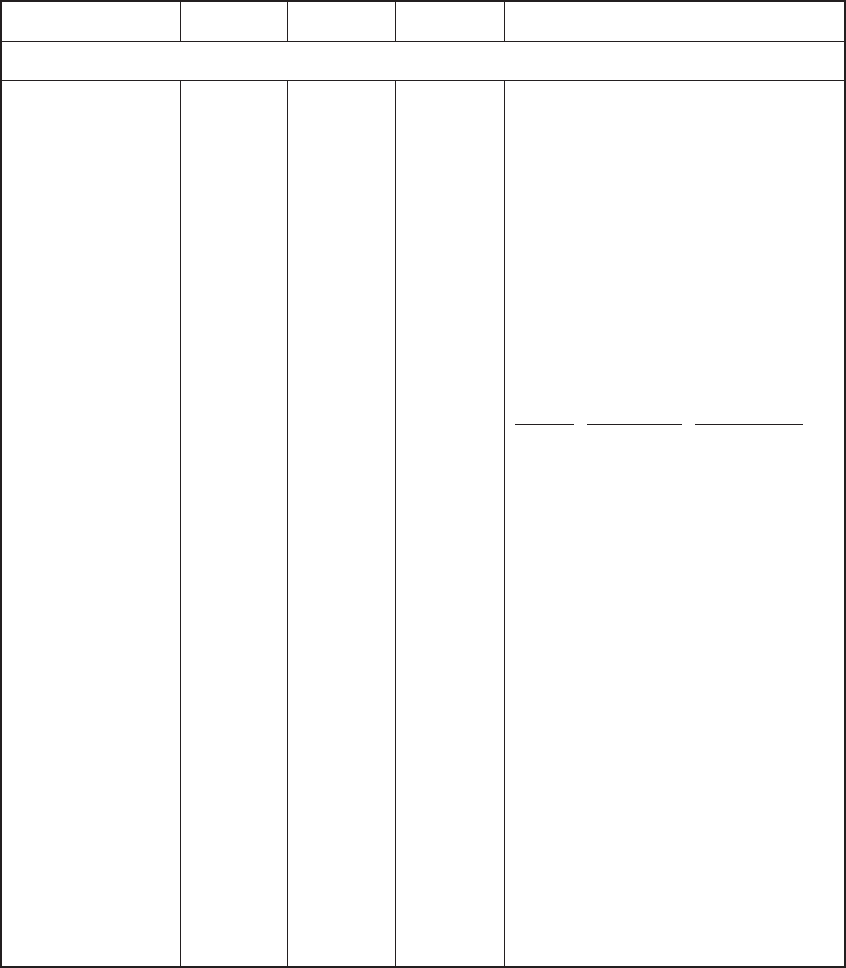
User's Guide
Code Sets D-45
Table D-6. Epson and IBM Escape Sequences––continued
Function ASCII Hexadecimal Decimal Description
Graphic Functions––continued
Print Epson JX .......................... ESC * m 1B 2A m 27 42 m For example, to print 300 columns, n2 would be 1 and n1
graphics (continued) n1 n2 list n1 n2 list n1 n2 list would be 44 (300 = (256 x 1) + 44).
The list in the sequence is a series of codes that define the
columns to print. The first code defines the first column, the
second code defines the second column, and so on. Each bit in a
code controls a specific dot in the column. The most significant
bit controls the top dot, the next bit controls the second dot, and so
on. If the bit is "1", the dot prints; if the bit is "0", the dot does not
print. For example, FF hex prints all eight dots in the column, 00
hex prints no dots, 0F hex prints the lower four dots, and F0 hex
prints the upper four dots.
Print Epson LQ-2550 ............... ESC * m 1B 2A m 27 42 m This sequence prints bit-image graphics, wherein character
graphics n1 n2 list n1 n2 list n1 n2 list codes no longer print characters, but instead print 8-dot-high or
24-dot-high columns of dots on the current print line. Depending
on the mode, the columns are spaced from 1/60 to 1/360 inch
apart and dots within each column are spaced either 1/72 inch
apart or 1/180 inch apart. This sequence does not change the
current line spacing. Variable m in the sequence determines
which graphics mode the printer uses.
Variable m
Mode Resolution ASCII Hex Dec
Single 72V x 60H dpi NUL 00 0
Double 72V x 120H dpi SOH 01 1
HS double 72V x 120H dpi STX 02 2
Quadruple 72V x 240H dpi ETX 03 3
CRT I 72V x 80H dpi EOT 04 4
CRT II 72V x 90H dpi ACK 06 6
Single 180V x 60H dpi SP 20 32
Double 180V x 120H dpi ! 21 33
CRT III 180V x 90H dpi & 26 38
Triple 180V x 180H dpi ' 27 39
Hex 180V x 360H dpi ( 28 40
In the HS double, quadruple and hex modes, consecutive
horizontal dots are not permitted. If the sequence specifies
consecutive horizontal dots, the printer does not print the second
dot.
Variables n1 and n2 define the number of columns to print. For
modes with 72 dots per vertical inch, this number equals the
number of bytes in the list. For modes with 180 dots per vertical
inch, this number equals one-third the number of bytes in the list.
The printer interprets n1 and n2 as follows:
Number of columns = (256 x n2) + n1
For example, to print 300 columns, n2 would be 1 and n1 would
be 44 (300 = (256 x 1) + 44).
User's Guide
Code Sets D-45
Table D-6. Epson and IBM Escape Sequences––continued
Function ASCII Hexadecimal Decimal Description
Graphic Functions––continued
Print Epson JX .......................... ESC * m 1B 2A m 27 42 m For example, to print 300 columns, n2 would be 1 and n1
graphics (continued) n1 n2 list n1 n2 list n1 n2 list would be 44 (300 = (256 x 1) + 44).
The list in the sequence is a series of codes that define the
columns to print. The first code defines the first column, the
second code defines the second column, and so on. Each bit in a
code controls a specific dot in the column. The most significant
bit controls the top dot, the next bit controls the second dot, and so
on. If the bit is "1", the dot prints; if the bit is "0", the dot does not
print. For example, FF hex prints all eight dots in the column, 00
hex prints no dots, 0F hex prints the lower four dots, and F0 hex
prints the upper four dots.
Print Epson LQ-2550 ............... ESC * m 1B 2A m 27 42 m This sequence prints bit-image graphics, wherein character
graphics n1 n2 list n1 n2 list n1 n2 list codes no longer print characters, but instead print 8-dot-high or
24-dot-high columns of dots on the current print line. Depending
on the mode, the columns are spaced from 1/60 to 1/360 inch
apart and dots within each column are spaced either 1/72 inch
apart or 1/180 inch apart. This sequence does not change the
current line spacing. Variable m in the sequence determines
which graphics mode the printer uses.
Variable m
Mode Resolution ASCII Hex Dec
Single 72V x 60H dpi NUL 00 0
Double 72V x 120H dpi SOH 01 1
HS double 72V x 120H dpi STX 02 2
Quadruple 72V x 240H dpi ETX 03 3
CRT I 72V x 80H dpi EOT 04 4
CRT II 72V x 90H dpi ACK 06 6
Single 180V x 60H dpi SP 20 32
Double 180V x 120H dpi ! 21 33
CRT III 180V x 90H dpi & 26 38
Triple 180V x 180H dpi ' 27 39
Hex 180V x 360H dpi ( 28 40
In the HS double, quadruple and hex modes, consecutive
horizontal dots are not permitted. If the sequence specifies
consecutive horizontal dots, the printer does not print the second
dot.
Variables n1 and n2 define the number of columns to print. For
modes with 72 dots per vertical inch, this number equals the
number of bytes in the list. For modes with 180 dots per vertical
inch, this number equals one-third the number of bytes in the list.
The printer interprets n1 and n2 as follows:
Number of columns = (256 x n2) + n1
For example, to print 300 columns, n2 would be 1 and n1 would
be 44 (300 = (256 x 1) + 44).


















